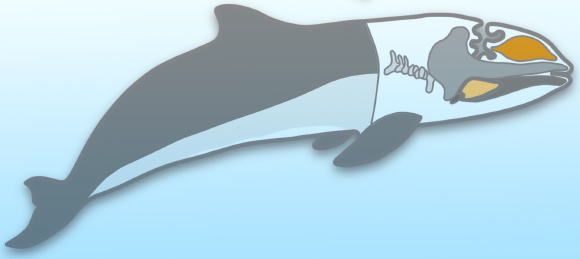Toothed whales have developed specialized echolocation abilities that are crucial for their underwater activities. Acoustic fat bodies — the melon in the whale forehead, extramandibular fat bodies alongside the jawbone, and intramandibular fat bodies within the jawbone — are vital for echolocation. In a new study, researchers at Hokkaido University analyzed DNA sequences of genes expressed in acoustic fat bodies in two toothed whale species, the harbor porpoise (Phocoena phocoena) and Pacific white-sided dolphin (Lagenorhynchus obliquidens), revealing some insight into their evolutionary origins and ecological significance.
Illustration of the body plan of a toothed whale, with a cross section of the head showing the melon (dark yellow) and the extramandibular fat bodies (light yellow) which are key organs for using sound such as echolocation. Image credit: Takeuchi et al., doi: 10.1016/j.gene.2024.148167.
Toothed whales, which include porpoises, dolphins, and certain whales, possess specialized echolocation abilities.
This lineage-specific skill is crucial to underwater navigation, hunting, and communication, which relies on the emission of high-frequency clicks.
Specific tissues are known as acoustic fat bodies within the heads of toothed whales, contributing to their echolocation capabilities.
Scientists believe that acoustic fat bodies are one of the novel traits acquired in the aquatic adaptation of toothed whales.
However, their origins remain unclear and necessitate the formulation of a kind of hypothesis that a prototype of acoustic fat bodies existed.
“Toothed whales have undergone significant degenerations and adaptations to their aquatic lifestyle,” said Hayate Takeuchi, a Ph.D. student at Hokkaido University.
“One adaptation was the partial loss of their sense of smell and taste, along with the gain of echolocation to enable them to navigate in the underwater environment.”
In their study, Takeuchi and colleagues found that genes which are normally associated with muscle function and development were active in the melon and extramandibular fat bodies.
There was also evidence of an evolutionary connection between the extramandibular fat and the masseter muscle, which in humans connects the lower jawbone to the cheekbones and is a key muscle involved in chewing.
“Our study has revealed that the evolutionary tradeoff of masticatory muscles for the extramandibular fat bodies — between auditory and feeding ecology — was crucial in the aquatic adaptation of toothed whales,” said Dr. Takashi Hayakawa, a researcher at Hokkaido University.
“It was part of the evolutionary shift away from chewing to simply swallowing food, which meant the chewing muscles were no longer needed.”
“Analysis of gene expression in the intramandibular fat detected activity of genes related to immune functions, such as the activation of some elements of the immune response and regulation of T cell formation.”
A paper describing the findings was published in the journal Gene.
_____
Hayate Takeuchi et al. 2024. A tradeoff evolution between acoustic fat bodies and skull muscles in toothed whales. Gene 901: 148167; doi: 10.1016/j.gene.2024.148167


